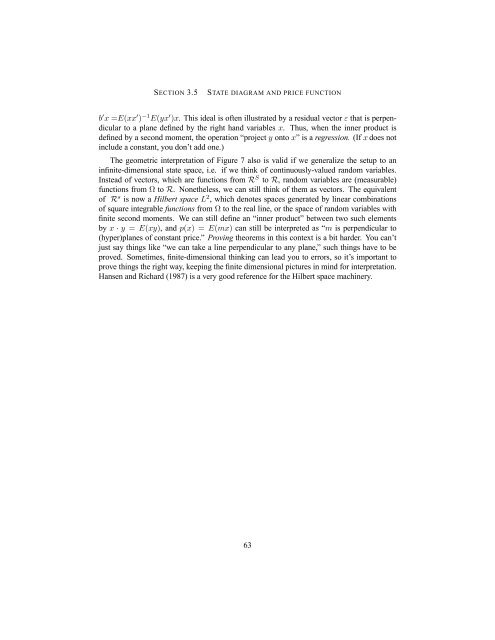Asset Pricing John H. Cochrane June 12, 2000
Asset Pricing John H. Cochrane June 12, 2000
Asset Pricing John H. Cochrane June 12, 2000
Create successful ePaper yourself
Turn your PDF publications into a flip-book with our unique Google optimized e-Paper software.
SECTION 3.5 STATE DIAGRAM AND PRICE FUNCTION<br />
b 0 x =E(xx 0 ) −1 E(yx 0 )x. This ideal is often illustrated by a residual vector ε that is perpendicular<br />
to a plane definedbytherighthandvariablesx. Thus, when the inner product is<br />
defined by a second moment, the operation “project y onto x” isaregression. (If x does not<br />
include a constant, you don’t add one.)<br />
The geometric interpretation of Figure 7 also is valid if we generalize the setup to an<br />
infinite-dimensional state space, i.e. if we think of continuously-valued random variables.<br />
Instead of vectors, which are functions from R S to R, random variables are (measurable)<br />
functions from Ω to R. Nonetheless, we can still think of them as vectors. The equivalent<br />
of R s is now a Hilbert space L 2 , which denotes spaces generated by linear combinations<br />
of square integrable functions from Ω to the real line, or the space of random variables with<br />
finite second moments. We can still define an “inner product” between two such elements<br />
by x · y = E(xy), andp(x) =E(mx) can still be interpreted as “m is perpendicular to<br />
(hyper)planes of constant price.” Proving theorems in this context is a bit harder. You can’t<br />
just say things like “we can take a line perpendicular to any plane,” such things have to be<br />
proved. Sometimes, finite-dimensional thinking can lead you to errors, so it’s important to<br />
prove things the right way, keeping the finite dimensional pictures in mind for interpretation.<br />
Hansen and Richard (1987) is a very good reference for the Hilbert space machinery.<br />
63
















